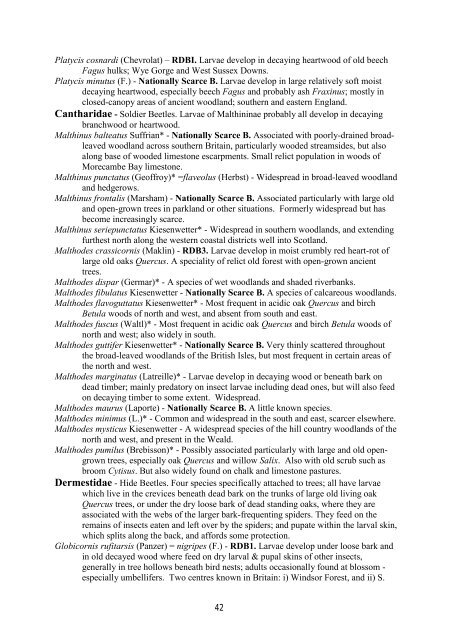Crustacea: Copepoda - Cerambycoidea.com
Crustacea: Copepoda - Cerambycoidea.com
Crustacea: Copepoda - Cerambycoidea.com
Create successful ePaper yourself
Turn your PDF publications into a flip-book with our unique Google optimized e-Paper software.
Platycis cosnardi (Chevrolat) – RDBI. Larvae develop in decaying heartwood of old beech<br />
Fagus hulks; Wye Gorge and West Sussex Downs.<br />
Platycis minutus (F.) - Nationally Scarce B. Larvae develop in large relatively soft moist<br />
decaying heartwood, especially beech Fagus and probably ash Fraxinus; mostly in<br />
closed-canopy areas of ancient woodland; southern and eastern England.<br />
Cantharidae - Soldier Beetles. Larvae of Malthininae probably all develop in decaying<br />
branchwood or heartwood.<br />
Malthinus balteatus Suffrian* - Nationally Scarce B. Associated with poorly-drained broadleaved<br />
woodland across southern Britain, particularly wooded streamsides, but also<br />
along base of wooded limestone escarpments. Small relict population in woods of<br />
Morecambe Bay limestone.<br />
Malthinus punctatus (Geoffroy)* =flaveolus (Herbst) - Widespread in broad-leaved woodland<br />
and hedgerows.<br />
Malthinus frontalis (Marsham) - Nationally Scarce B. Associated particularly with large old<br />
and open-grown trees in parkland or other situations. Formerly widespread but has<br />
be<strong>com</strong>e increasingly scarce.<br />
Malthinus seriepunctatus Kiesenwetter* - Widespread in southern woodlands, and extending<br />
furthest north along the western coastal districts well into Scotland.<br />
Malthodes crassicornis (Maklin) - RDB3. Larvae develop in moist crumbly red heart-rot of<br />
large old oaks Quercus. A speciality of relict old forest with open-grown ancient<br />
trees.<br />
Malthodes dispar (Germar)* - A species of wet woodlands and shaded riverbanks.<br />
Malthodes fibulatus Kiesenwetter - Nationally Scarce B. A species of calcareous woodlands.<br />
Malthodes flavoguttatus Kiesenwetter* - Most frequent in acidic oak Quercus and birch<br />
Betula woods of north and west, and absent from south and east.<br />
Malthodes fuscus (Waltl)* - Most frequent in acidic oak Quercus and birch Betula woods of<br />
north and west; also widely in south.<br />
Malthodes guttifer Kiesenwetter* - Nationally Scarce B. Very thinly scattered throughout<br />
the broad-leaved woodlands of the British Isles, but most frequent in certain areas of<br />
the north and west.<br />
Malthodes marginatus (Latreille)* - Larvae develop in decaying wood or beneath bark on<br />
dead timber; mainly predatory on insect larvae including dead ones, but will also feed<br />
on decaying timber to some extent. Widespread.<br />
Malthodes maurus (Laporte) - Nationally Scarce B. A little known species.<br />
Malthodes minimus (L.)* - Common and widespread in the south and east, scarcer elsewhere.<br />
Malthodes mysticus Kiesenwetter - A widespread species of the hill country woodlands of the<br />
north and west, and present in the Weald.<br />
Malthodes pumilus (Brebisson)* - Possibly associated particularly with large and old opengrown<br />
trees, especially oak Quercus and willow Salix. Also with old scrub such as<br />
broom Cytisus. But also widely found on chalk and limestone pastures.<br />
Dermestidae - Hide Beetles. Four species specifically attached to trees; all have larvae<br />
which live in the crevices beneath dead bark on the trunks of large old living oak<br />
Quercus trees, or under the dry loose bark of dead standing oaks, where they are<br />
associated with the webs of the larger bark-frequenting spiders. They feed on the<br />
remains of insects eaten and left over by the spiders; and pupate within the larval skin,<br />
which splits along the back, and affords some protection.<br />
Globicornis rufitarsis (Panzer) = nigripes (F.) - RDB1. Larvae develop under loose bark and<br />
in old decayed wood where feed on dry larval & pupal skins of other insects,<br />
generally in tree hollows beneath bird nests; adults occasionally found at blossom -<br />
especially umbellifers. Two centres known in Britain: i) Windsor Forest, and ii) S.<br />
42

















